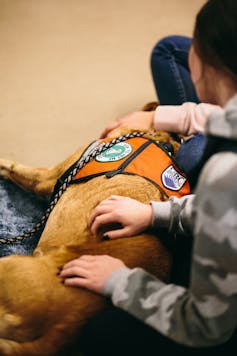
For those of us fortunate to have canine companions in our lives, how we interact with them can have an impact on our well-being. Research findings align with what many folks already intuitively knew about the benefits of sharing life with a pet. Pets, and dogs in particular, provide a nonjudgmental source of support and companionship and being in their presence makes us feel better.
Several studies have supported the offering of canine-assisted interventions to reduce student stress. On-campus canine stress-reduction programs, like the University of British Columbia’s B.A.R.K. program, are a popular approach to providing students opportunities to spend time with therapy dogs to bolster their well-being.
Although we knew that spending time with therapy dogs was beneficial, little was known about how these interactions contributed to people feeling better. My research team, comprising B.A.R.K. Program Coordinator Freya Green and doctoral student Zakary Draper, examined the best way to interact with the dogs in our lives.
Read more: Dog therapy: What I've learned overseeing 60 canine campus teams
Proximity matters

To tease apart the effects of interacting with therapy dogs through touch, we randomly assigned 284 undergraduate students to one of three conditions: direct contact and touching a therapy dog; being next to but not touching a therapy dog; and a control condition in which there was a dog-handler but no dog.
Care was taken across settings to ensure that the interventions were administered as intended. This included measuring the distance from the dog and the handler and the distance between participating students. Upholding animal welfare standards, the welfare of the therapy dogs in this study was monitored within each session to identify any signs of distress — none were reported.
To measure the impact of these different 20-minute sessions, participants were asked to complete pre- and post-visit measures that captured their self-ratings on both positive (flourishing, happiness, social connectedness) and negative (stress, loneliness, homesickness) dimensions of well-being.
Curiously, the findings revealed that participants in both dog conditions saw significant reductions in their stress, loneliness and negative affect. We might interpret this to mean that even being in the vicinity of a dog can reduce some of our negative feelings.
The key finding from the study revealed that participants who got to directly interact with the dogs experienced significant pre-to-post test changes across all measures. In addition, when the direct touch condition was analyzed in comparison to the no-touch condition, participants reported significantly greater reductions in stress, homesickness, loneliness and negative affect. They also reported significantly greater improvements in positive affect, social connectedness and subjective happiness.
In short, spending time petting and scratching a therapy dog significantly boosted participants’ well-being, especially when compared to just being in proximity of a dog.
Touch therapy

The findings of this study hold implications for student support services or health personnel across campuses who strive to provide opportunities for students to reduce their stress.
Stress-reduction events are often held during final exams, but it’s really the management of stress over the course of the semester that is key to avoiding the accumulation of debilitating levels of stress.
Increasingly, researchers have identified that being a college student is a stressful experience. Students, especially first-year students who are outside the watchful eye of parents for the first time, must adapt to new academic expectations and the challenges associated with communal housing.
Additionally, there are new friendships and social support networks that must be established and nurtured as students find and create their on-campus community.
Added to these challenges is that students are, overall, reluctant help-seekers; they often avoid formal resources and opportunities aimed at supporting their mental health.
Supporting students
On-campus canine stress-reduction programs are what we’d call a low-barrier resource because they typically don’t require students to book appointments. These programs are not intended as a primary mental health intervention, but rather a resource that can help redirect students to other sources of support.
Whether you have a dog lying at your feet as you read this or you have to seek out opportunities to spend time with dogs, be mindful that how you interact with dogs can impact how you feel. Take the time to scratch dogs behind the ears, give belly rubs and ensure you interact with dogs through touch. You’ll walk away feeling better. And the added bonus is that this feeling will likely be shared by your canine companion!
Dr. Binfet's research is funded in part by the Social Sciences and Humanities Research Council of Canada.
This article was originally published on The Conversation. Read the original article.







